
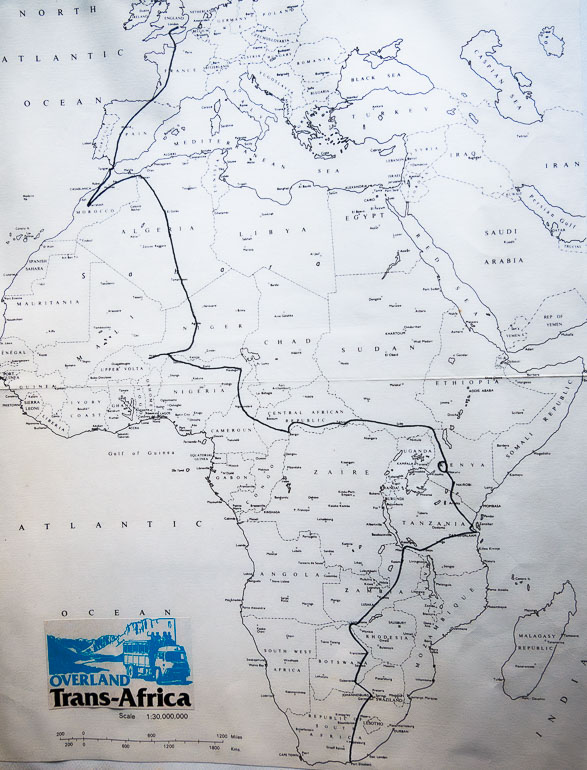
Soper Lodge, Johannesburg, 6 August 1980
Washing underpants and socks in the washbasin of a cheap hotel room. Back on the road again. Everything is run-down and dirty, including me. Desperately tired, jet lag strikes with deadly accuracy; eyes sore, head hazy. Threadbare blankets, no towel, no plug for the wash basin, cobwebs, and the wardrobe door is broken. The curtains won’t reach across to cover the window, a bare bulb hangs from the ceiling. Alone. Desperately tired. And not even a fucking ashtray. Back on the road again.
The cost of staying in this luxurious hotel is five Rand. Well what did I expect for five Rand? And it includes dinner, bed, breakfast, and morning and afternoon tea. Dinner: vegetable soup – it’s okay; then a three-inch square of fish covered in white sauce with black blobs in it – I don’t eat it; canned sweetcorn in mushroom sauce mushy and tasteless – after three mouthfuls I don’t eat it; then steak and potatoes and boiled cabbage. Two mouthfuls of the potatoes before I notice the grey flecks in it – I don’t eat it. I don’t eat meat, and boiled cabbage is revolting under any circumstances; dessert is listed as steamed orange pudding but is actually crumbly ice cream (how old is it?) with peach jelly (jello). Living dangerously I eat the jelly.
An old man sits opposite me, bald with mottled pate and florid face he splutters and mumbles his way through the meal (eating everything!) all the while organizing and reorganizing all the things on the table.
The smell. Oh my god the smell. It permeates the entire building; boiled cabbage and stale piss. Well what can you expect for five Rand?
A few weeks earlier I’d been working in an iron ore mining town in the remote West Australian desert saving for my next adventure. In 1978 while on a four-month overland trip in South America I learned that I could do the same in Africa. That’s it! I’m doing that next!
At last it’s time. I fly to my childhood home in Canberra, find a brochure in a travel agency that advertises a four-month overland trip from Johannesburg to London with Exodus Expeditions leaving about mid-August. This is it. Preparations: visas, vaccinations, a new backpack, collecting all the things I’ll need, booking accommodation in Johannesburg. There’s no google; heck, there’s no internet. I probably found Soper Lodge in a book called “Someplace on a Shoestring”.
August 5th: lying in bed unable to sleep. In the morning I fly from Canberra to Perth to Johannesburg. I’m wide awake with a heady mix of trepidation and excitement.
The morning after the night in the sad Soper I take a train from Johannesburg to Port Elizabeth, now known by its original name: Gqeberha. The pronunciation is a guttural G which includes almost an r sound then bare ha. I’m pleased for this acknowledgement of the original inhabitants of the area, but I’ll never be able to pronounce it. In Port Elizabeth I stay a couple of nights with friends of friends who live in a wonderful iconic Cape Dutch house, a style of architecture that is local to South Africa and has roots in medieval Netherlands, Germany and France.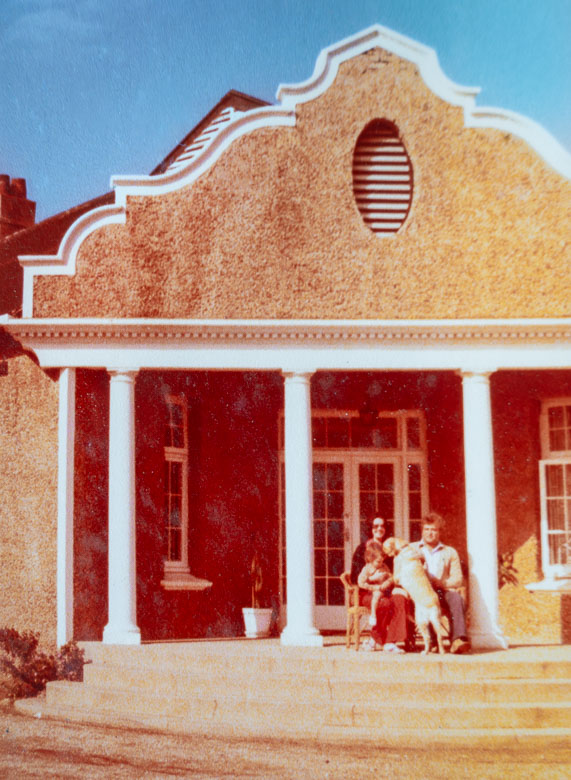
They invite friends over for a brai, the South African word for barbecue. We also go to the beach. I have photos of the rolling sand dunes, and these beautiful aloes.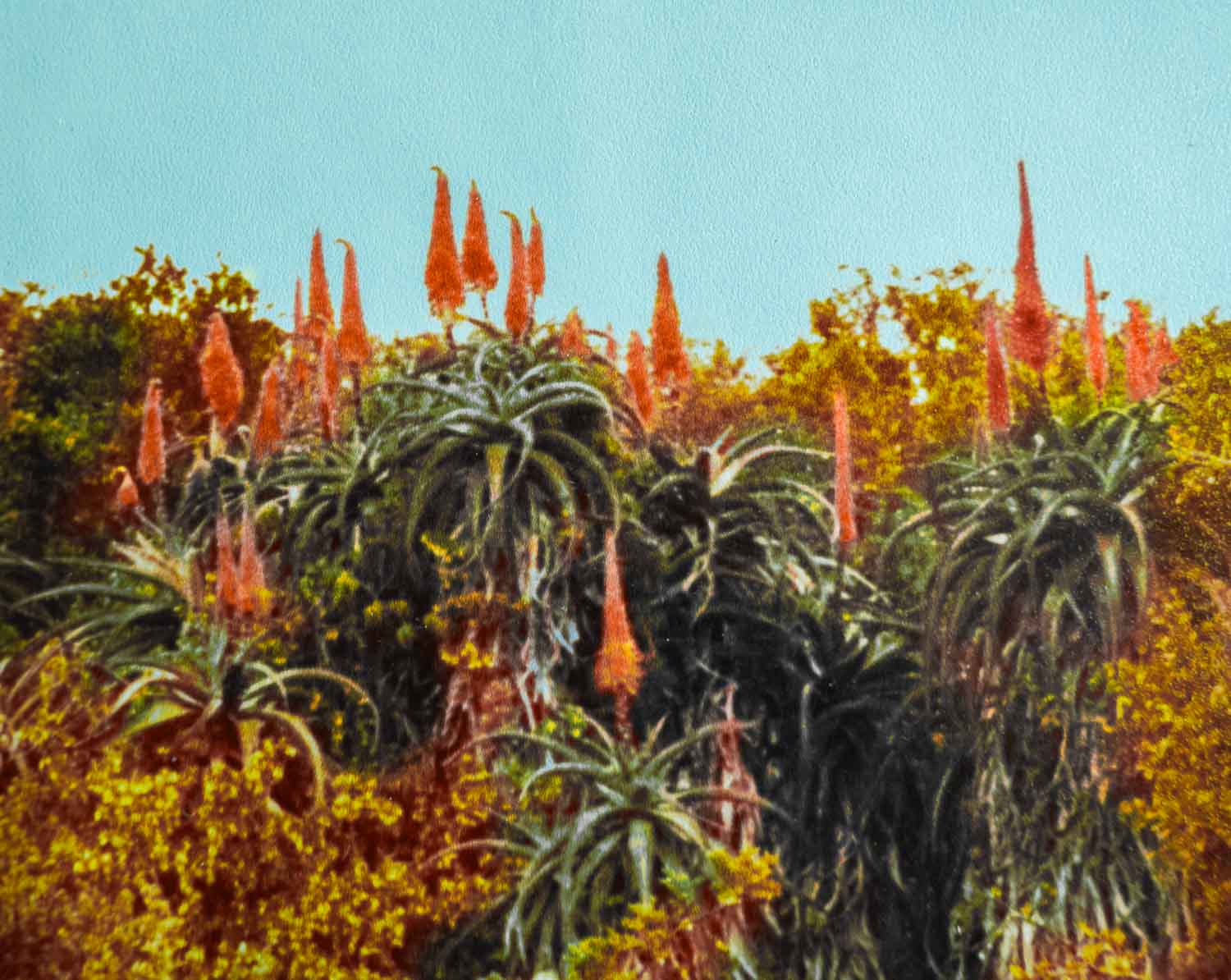
I barely remember any of that whole trip. It’s a distance of 1000 kilometres each way, but I don’t take a single photo from the train.
Back in Johannesburg I book into the Allendene Hotel, recommended by Exodus, and meet some of the people I’ll be travelling with. The Allendene, though homey, is a significant upgrade from the sad Soper.
Among all the information I’m given by Exodus about the expedition there’s this little gem that really says everything: It is essential to be mentally prepared for an African expedition, and part of that preparation consists of the realisation that once out in the depths of Africa there is no such thing as an itinerary or a schedule. There is only an objective – to get to your destination by whatever route is open.
Initially this isn’t really applicable. The road northwest to Gaborone in Botswana is good enough. We camp every night, getting used to the tent routine, and the cooking and camp-fire routine. And each other.
There’s Craig, the expedition leader, Brett his co-driver, and the six of us. Four more will join us in Nairobi in about a month.
We camp by the great grey-green greasy Limpopo River, a description made so famous by Rudyard Kipling that I can’t think of the Limpopo without it. Just the idea of it and I’m filled with wonder. I’m here! By the great grey-green greasy Limpopo River! Unexpectedly a childhood story has become a reality.
The campfire glows,
a thousand stories hidden deep within
and imagination takes over.
Africa lies ahead
and we all sit tentatively
reaching out to each other
slowly
a step at a time
testing . . . .
We follow the river north towards Francistown, passing several villages along the way,
until eventually crossing the Zambezi River, and the border, into Zambia at Kazungula. The ferry across the river is no more than an old wooden platform with an engine attached. The following image shows a similar though slightly more primitive set-up in Central African Republic. Either way the ferry is a far cry from the fancy new bridge that exists today, likely financed by China.
We turn east to Livingston, the gateway to Victoria Falls, and the first real highlight of the trip. Victoria Falls is part of the mighty Zambezi River, which forms the border between Zimbabwe and Zambia; Zimbabwe to the west and Zambia to the east. At 885 metres (2,900 ft) tall, it is considered to be the world’s largest sheet of falling water, inevitably accompanied by a thundering roar, though I remember being more impressed by Iguazu Falls in Brazil; perhaps it was the butterflies. Still, there’s no denying Victoria Falls is pretty phenomenal. We camp by the Zambezi River for two nights with the roar of the falls to lull us to sleep.

Zambezi River Sunset
wide blue rolling deep
we sit immersed in jungle green
the sun fairly glows above the trees
a circle of red paper pasted
onto the sky.
crackling twigs walk behind me.
the red-orange circle
slips slowly down spreading across the river
and the water is no longer blue,
but turned red-orange, turned cerise,
turned pink, turned mauve
advancing slowly towards us
and we all wait in deep silence
turned inwards
turned outwards
immersed.
the circle is halved, and halved again
spreading fire sparks
behind the trees
disappearing to blackness.
grey-mauve takes over
and all around
to the farthest reaches of the horizon
to the farthest depths of imagination
and back again
night sounds rise up from the earth.
From Victoria Falls it’s two or three days driving, stopping in Lusaka,
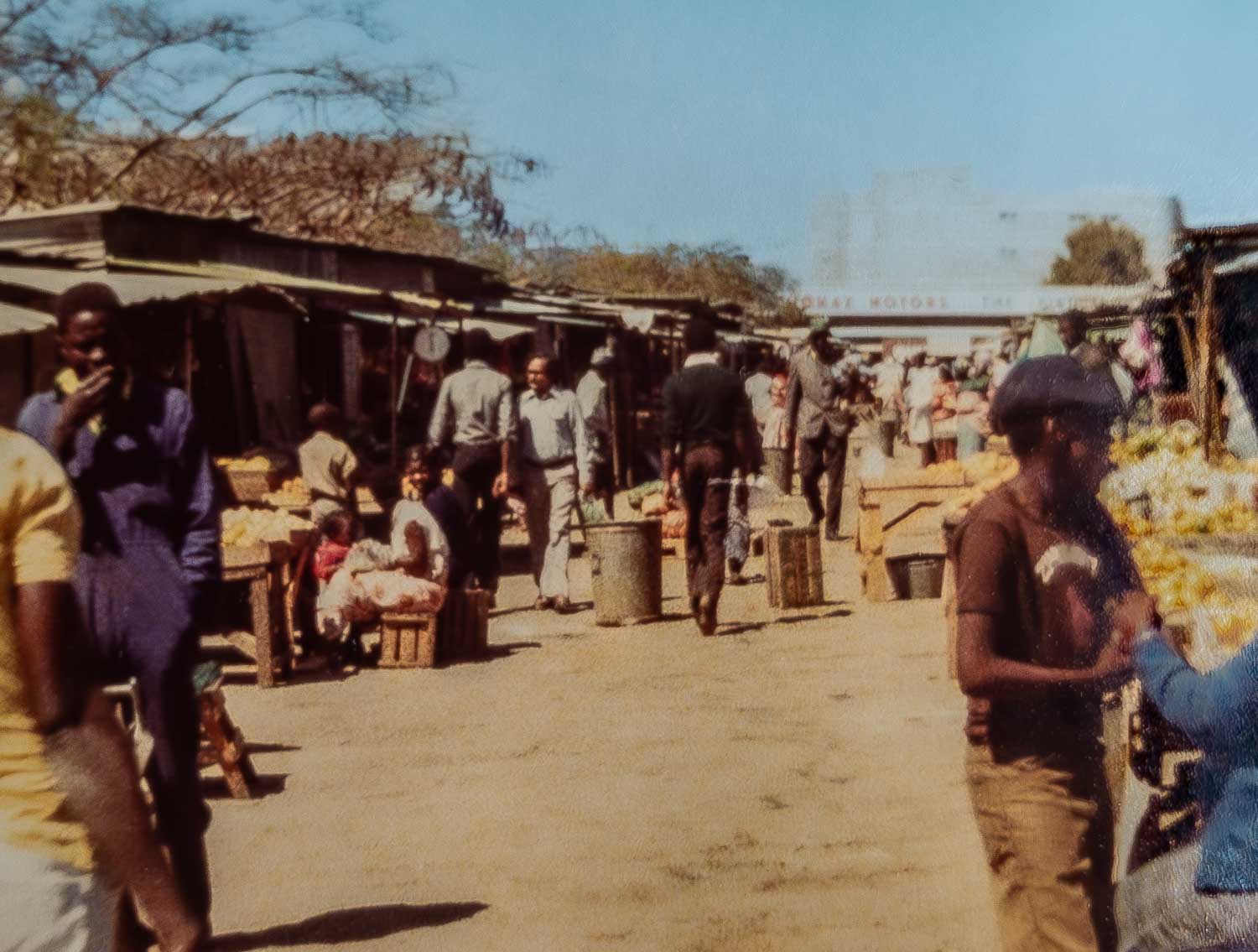

and other towns for groceries. It’s in Lusaka that I pick up postcards of these woodcut prints; powerful images of the people of Zambia trying to emerge from the yoke of colonialism. They are by Henry Tayali, Zambia’s most famous artist; multi-lingual painter, sculptor, printmaker, raconteur and lecturer.


Instead of going directly northeast to cross into Tanzania at Tunduma, we branch off and head northwest – to Kalambo Falls. Neither Brett nor Craig has been there but they’d heard good things about it. Located 24 kilometres from Mbala, even today Kalambo Falls is only accessible by 4x4s.
20 August 1980: We rise early as usual, pack up camp, head north towards the border then turn off the main road onto a dirt track. Steve and I sit up on the roof of the truck. Like this shot of Cameron, Steve, and Eric: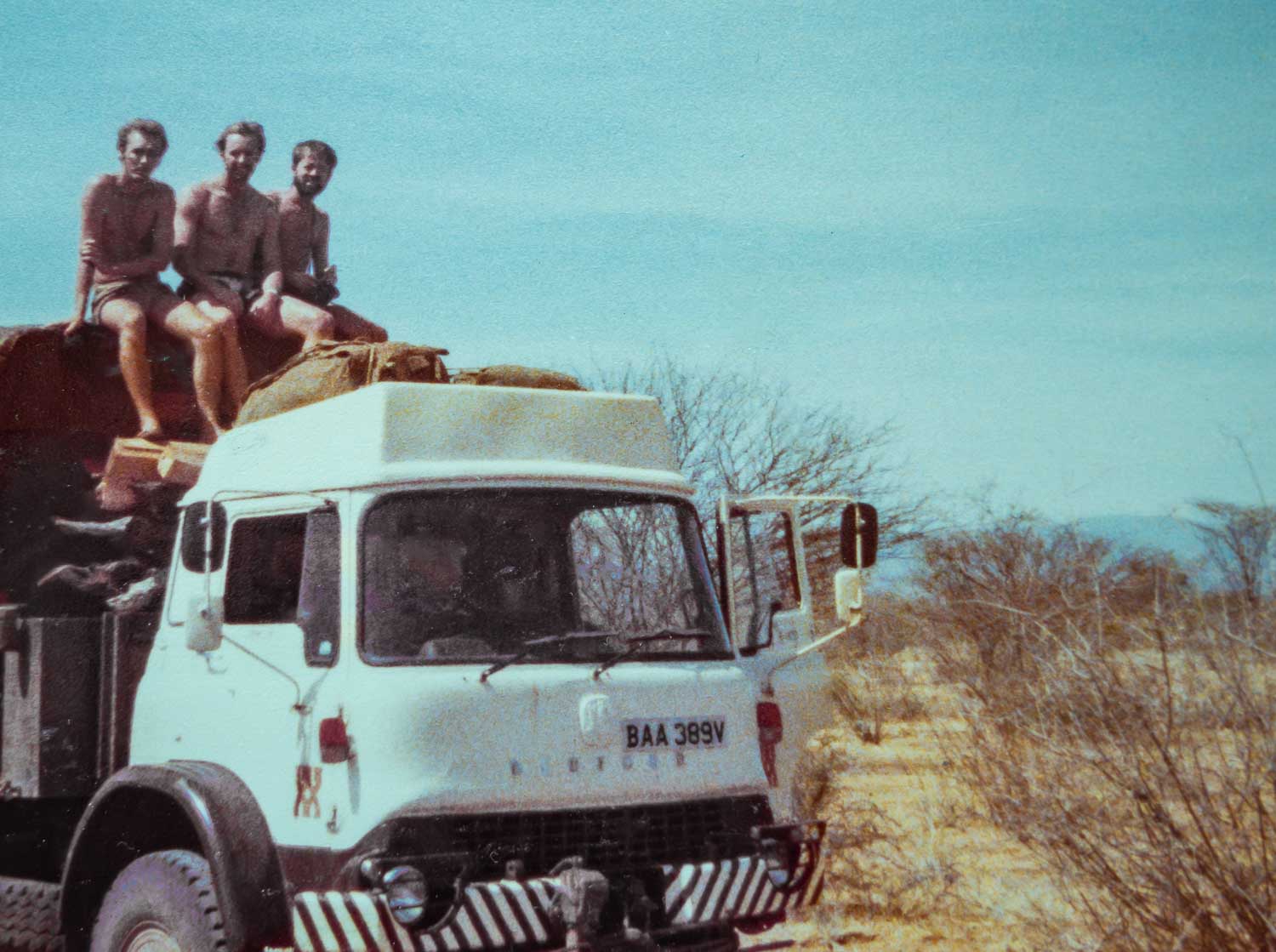
The feeling is indescribable, a clear view all round, sitting above the world; driving along the narrow dirt road, hills in the distance, blue-blue sky, trees surrounding red green and yellow, with thatched huts scattered in amongst them. And all the children come running to the side of the road to watch us go by, shouting and waving and dancing, bright eyes and white teeth flashing. And we are shouting too, and singing at the tops of our voices, screaming and yahooing at the world, at the beautiful scenery, sunny sky, joy and freedom of being on the road. And so we bellow our way to isolated Kalambo Falls, very much off the overland route, surrounded by grey-green mountains and falls cascading down through 244 metres (800 ft). There is no one here but us.
We arrive at the top of the falls; they cascade down below us. What we don’t see is this – the view of Kalambo Falls from across the valley.
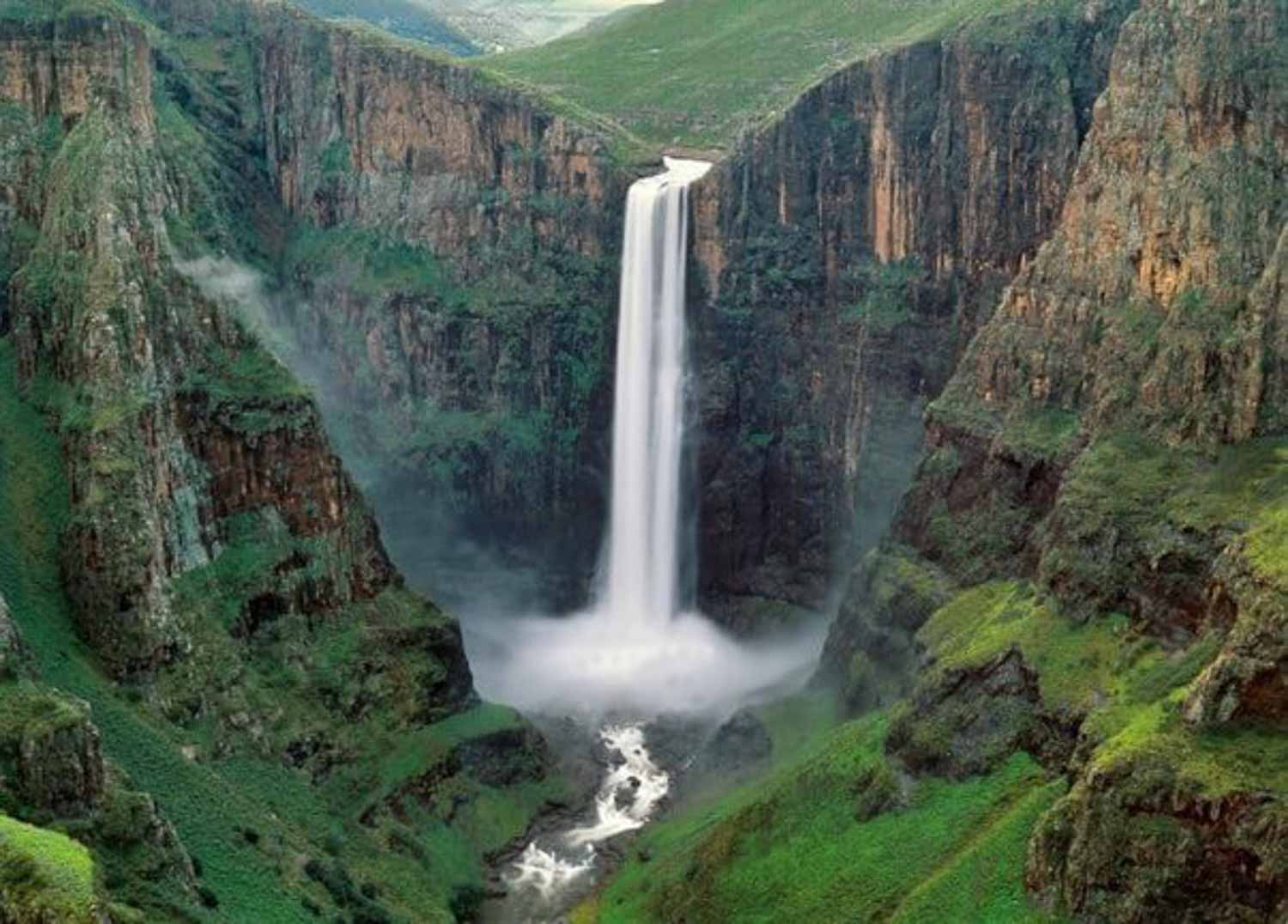
I’m first off the truck. I race down a small hill towards the falls and am stopped in my tracks. There’s a pool just a little below me,

and in it is a whole cartload of monkeys! I am filled with wide-eyed wonder. A little later I walk to the edge of the cliff and suddenly just below me a marabou stork flies out from its nest in the cliff-face, picks up the current and soars past, wings bent slightly downward at the tips, neck outstretched. More wide-eyed wonder. We walk around the top of the cliff; stand too close to the edge; watch the stork flying; look down over the falls as they hurtle down;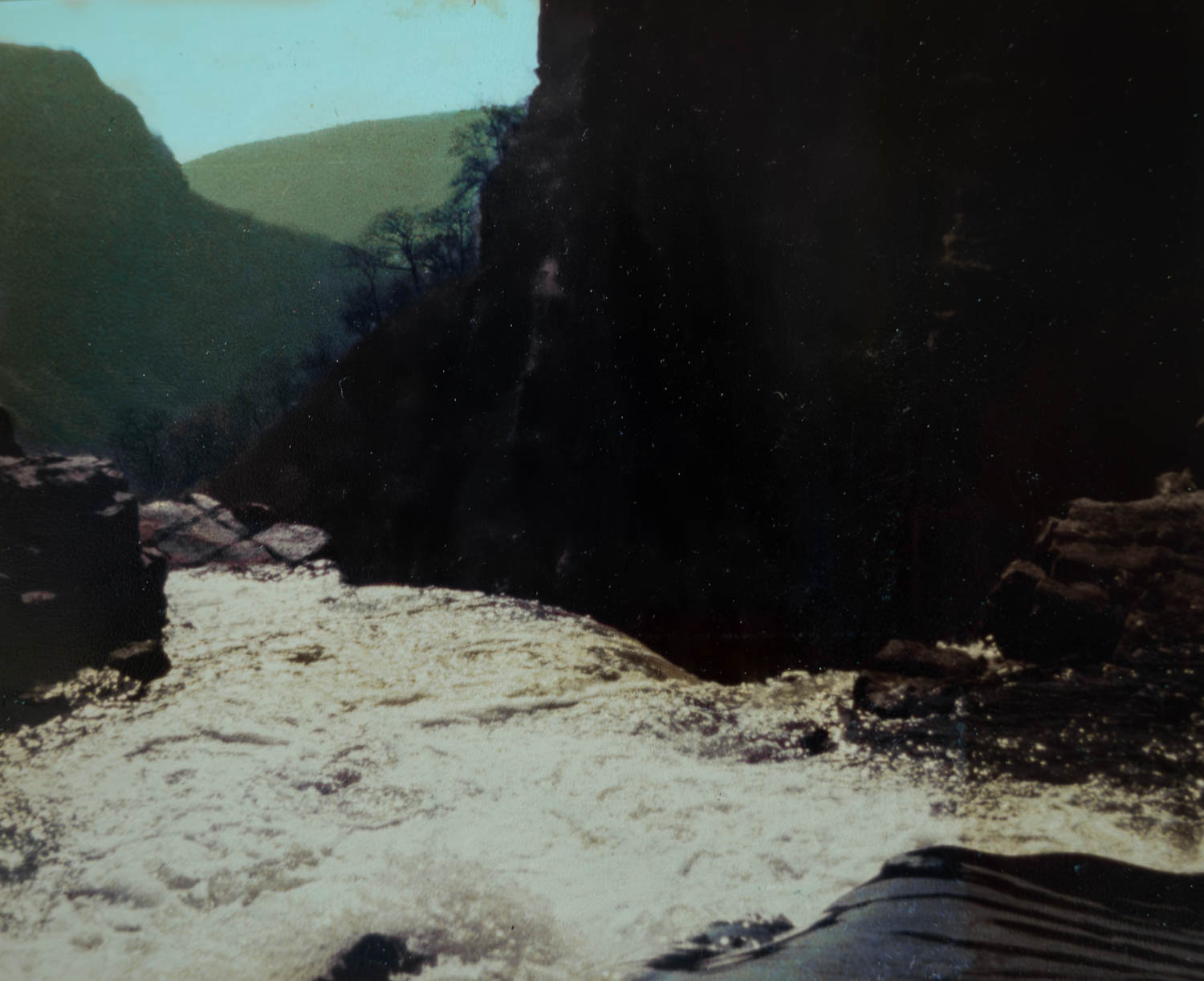
and look down, way down into the distant green tree tops below us – a frisson of fear, and a world of wonder.
And then I hear the drums, echoing and reverberating throughout the mountains, rhythms settling in and then changing, an audible smoke-signal. We’d heard that many of the people in this area had never seen white people and now the message is beating out from kraal to kraal that there are white people at the falls. The drums stir in me every story I’d ever heard about deepest darkest Africa. It’s eerie, disquieting, perhaps a little frightening, but at the same time thrilling and exciting. Soon they arrive, perhaps ten children and four or five men with spears and smiles and wide-eyed wonder to trade.
Later, joy of joys, I go to the pool at the top of the falls to bathe. Heaven! One of the great joys of travelling this way is that ordinary everyday things such as washing become special treats. So I get myself clean from head to foot and then watch the sun set over the mountains.
Sitting round the fire into the night, Brett and Craig make bread to bake in the small brick oven at the site;

desultory conversation, silence, laughter, the fire glows, and fresh baked crusty bread late at night before bed, my sleeping bag warm and cosy, wind slapping the tent.
Next post: Tanzania – a game park, thieves in the night, Dar es Salaam, and a drunken birthday by the beach in Bagamoyo.
And in future posts not country specific – organisation of chores, food and food stocks, cooking, personalities, getting clean, and staying safe.
Disclosure:
1. I’ve changed the names of everyone involved for privacy
2. Obviously any photo with me in it was taken by another member of the group, but I’ve no idea who.
All words and images by Alison Louise Armstrong unless otherwise noted
© Alison Louise Armstrong and Adventures in Wonderland – a pilgrimage of the heart, 2010-2024.

Great to read this. I was in Malawi in Peace Corp in 89–91. I remember those trucks full of “back packers”–naive me I thought they actually WALKED with those packs lol. So many memories here. I went to Victoria Falls, too. Thanks for posting this–I’m awash in memories. I can smell rice cooking and taste the boiled “chips” when there was no cooking oil.
LikeLiked by 1 person
Oh I’m so glad you enjoyed it, and that my post brought up some good memories for you; I like your phrase awash with memories. Me too. I didn’t write much after the first month but as I look through photos all kinds of memories are surfacing.
You must have had an amazing experience in Malawi!
Alison
LikeLiked by 1 person
Whoa! So fascinating to be reading about deep back in the history of your travelling heart. I really get it now that you aren’t so much a traveller as an adventurer! It’s also amazing that you still have the photos and your journals to draw from.
LikeLiked by 1 person
Thanks Kate. I’m glad you recognize my true calling 😁 It only took me until I was 23 after first becoming a librarian, and then a failed marriage, that it was time to stop trying to be what I thought my parents wanted me to be. Many adventures followed.
I have 3 huge scrapbooks of my early travels. When I moved to Canada I couldn’t bring myself to throw them away so I stowed them in a storage loft in my sister’s house. On one of my visits back to Oz I retrieved them. So glad I did!
Alison
LikeLike
I love that in the photo of all of you, you are holding a notepad and pencil. I am enjoying this very much. Look forward to more.
LikeLiked by 1 person
Thanks so much Darlene. I’m so glad you’re enjoying it. Finally it was time to document this journey in a 21st century way. Sorry to disabuse you, but that book I’m holding is the “bar” book. 😂 I ran a bar for the whole journey, buying whatever liquor I could find. The book was where people wrote down what drinks they helped themselves to. Will elaborate in some future post. Sadly I hardly wrote after the first month but still have some strong memories.
Alison
LikeLiked by 1 person
The “Bar” book. That is so funny. yes, you will have to tell us more at some time. xo
LikeLiked by 1 person
That’s an adventure, for sure! Bathing in the pool sounds heavenly.
LikeLiked by 1 person
A big yes to both the things you said! There were times getting clean was really challenging, so having a big pool of flowing fresh water was definitely heavenly.
Alison
LikeLiked by 1 person
An authentic adventure story. You don’t hide the unglamorous aspects, and this makes it so much more compelling. Travel in the pre-internet/digital days was so much wilder. I now wonder how we did it. I’m looking forward to the next installment!!
LikeLiked by 1 person
Thanks so much Julie; your comment means a lot to me. I agree travelling was wilder pre-internet, and I too wonder how I did it. I wish I’d made more notes!
Alison
LikeLike
So many memories. My first of three overlands in Africa was in 1977. The drums were wonderful back then.
LikeLiked by 1 person
I knew you’d relate. I loved following along on your most recent journey. Six months if I remember correctly. There is an adventure company that currently runs an 11 month one!
Alison
LikeLiked by 1 person
Our second overland was 11 months. The third was four. We have Madagascar coming up for a couple of weeks.
LikeLiked by 1 person
OMG you guys are insatiable. There is a company currently running 11 month trips – I can’t even imagine. Have a great time in Madagascar!
LikeLiked by 1 person
Alison, this is epic! It’s great that you still have the photos from this overland trip. I love that you had a piece of paper and a pen with you in that photo so that many years later you can share some of your notes with us. I always admire people who were able to do such challenging journey before the advent of the Internet.
LikeLiked by 1 person
Thanks Bama. Sadly the book is not my journal, but rather the “bar” book (see reply to Darlene). Sadly because I hardly wrote after about the first month.
After the journey I had my photos developed in London, and along with others on the trip we also got photos from each other. Then I made a huge scrapbook, which is where all this is coming from.
Alison
LikeLike
Wow! What an amazing adventure. Love getting a glimpse of your travels beginning. What a wonderful life story. Thanks for sharing.
LikeLiked by 1 person
Thanks Eileen. It really *was* an amazing adventure – definitely one of the highlights of all my travels. I’m so enjoying delving into the past to share this epic trip.
Alison
LikeLike
What a pleasure seeing the old photos and reading about your travels from so long ago. I especially enjoyed your poetry.
Steve
LikeLiked by 1 person
Thanks so much Steve. I’m having so much fun excavating all the photos, notes and memories. It was definitely time to share it in 21st century mode.
Thanks for your nice compliment about my poetry. I have a couple more to come, but sadly I didn’t write much more poetry after the first month or so, mainly I think because the further we went the harder it got – just to get through the jungle and then the Sahara took everything we had. All that to come!
Alison
LikeLike
What an amazing adventure Alison.
LikeLiked by 1 person
It really was! I really had no idea what I was getting myself into, but it turned out to be so fabulous in so many ways.
Alison
LikeLike
Loved this. I too travelled across Africa in 1980 but with Encounter Overland. And yes, even stayed at Soper Lodge. I remember buying hiking boots and walking up and down the hallway to get used to them as I didn’t want to walk the neighbourhood at night.
So many memories. Our group is still in touch.
LikeLiked by 1 person
OMG you did it too – and in the same year! Even the Soper! It must have been on the backpacker/overland route for us both to have found it. I went with Encounter in South America in ’78, and would have done in Africa too, but couldn’t find anything about it in the travel agency in Canberra, just the Exodus brochure. I laugh now that I didn’t think to sit down with a travel agent and get them to look into it for me.
I’m not in touch with anyone from the trip, though recently reconnected with 2 of the people from the Encounter trip.
Yes – so many memories!
Alison
LikeLike
Love this blast from your past, Alison! Everything about it is enchanting in an old “how the hell did I do that?!” way. Back then travel was so much more intrepid, and this trip seems to have been even at the extremes of that. I wish I’d know about overlanding in my earlier years; while I had a few of my own daring adventures, none was as exotic and cool as this. I look forward to more!
LikeLiked by 1 person
Thanks Lexie. Oh definitely “how the hell did I do that?!” And yes, travel was much more intrepid then, frequently going by word of mouth more than anything, and those Lonely Planet, and Shoestring guides. No doubt this trip was the most extreme of all my youthful travels. The South America expedition was tame in comparison. Apparently there are still Africa overland expeditions available in case you wanna go 🙂
Alison
LikeLiked by 1 person
I would do it in a heartbeat! Jeff would then divorce me. 🙂
LikeLiked by 1 person
Don would be the same 😂
LikeLiked by 1 person
What a great adventure! At a time when you travel without much knowledge of he place first. I really love your story from Kalambo Falls, with the monkeys, drums and locals with spears. How great that you still have your notes to relive this adventure. Maggie
LikeLiked by 1 person
It truly was an amazing adventure, with little knowledge of what we’d got ourselves into. The trip got tougher and tougher the longer it went on. Kalambo Falls was a really special day – definitely a highlight.
After the trip I made a huge scrap book with all the photos. And I kept all my notes, but sadly hardly wrote anything after the first month or so. Still the photos bring back lots of memories. Thanks Maggie.
Alison
LikeLiked by 1 person
This is epic! I’m glad you are sharing this journey, and I look forward to more pieces of the trip. I have not yet set foot in Africa but this is the stuff of all my imagining.
–Julia
LikeLiked by 1 person
Thanks Julia! What a fabulous comment – makes me so happy that you’re enjoying it. It really was an epic journey, and this was the easy part! Much more to come.
Alison
LikeLiked by 1 person
What a great adventure, Alison! Definitely a different era without internet and your group being the first white people to be seen! I love the timeless message of the drumming. Looking forward to the rest.
LikeLiked by 1 person
It really was an amazing adventure; definitely a highlight of all my travels, and it feels really good to be finally documenting it in a 21st century way.
The drumming was amazing😳
Alison xo
LikeLike
“There is only an objective – to get to your destination by whatever route is open.” – It’s not a recommendation for those with fainted hearts 🙂 It was literally a journey into the wild, with very little information. I look forward to reading more about your adventure in Africa! By the way, It’s nice to see you in the 30s, Alison 🙂
LikeLiked by 1 person
Thanks so much Len. Yes it really was a journey into the wild. Fortunately we had a very experienced expedition leader. Lots more to come!
Alison
LikeLiked by 1 person
Wow! quite the epic journey! Quite the brave souls you are!!
LikeLiked by 1 person
Thanks Sue, and yes it was truly epic. It was just me, at least me and the group I travelled with. Not Don. You couldn’t pay Don enough to travel this way 😂
LikeLike
Alison, your writing and recollections from this incredible once-in-a-lifetime overland trip hooked me in from the very first sentence. I’m going to echo what just about everyone else has said about it being more epic and intrepid than any long vacation in the 2020s. We have it so easy these days with Google and Wi-Fi everywhere and the Internet! I especially enjoyed your beautiful poetry written on the banks of the Zambezi.
The part about your journey to Kalambo Falls really struck a chord. It reminded me of the immense freedom that Bama and I felt during our six-month “Spice Odyssey” in 2015. (I can barely believe that was almost 10 years ago now.) The prospect of having no pesky work emails or lurking deadlines waiting at home is something I miss very dearly! Even if work is about travel and writing/editing stories on the endlessly wonderful things that are out there in the world. I guess I’m a little spoiled!
LikeLiked by 1 person
Thank you so much James. It’s wonderful to hear that you were engaged with my story. I have long felt that I learned how to write blog posts from reading yours. And thanks re the poetry. I still write some, but it comes and goes.
Travel really *was* more intrepid before the internet. I learned it from my mum, who used the library, travel agents, phone calls, and snail mail to create 3 long journeys that my parents did in the ’70s/early80s.
I well remember following your spice odyssey, and totally understand that kind of freedom. It really is enlivening in every way. And, yes, we can feel spoiled having once experienced that kind of freedom. It’s intoxicating.
Alison
LikeLiked by 1 person
I just spent several days with my friend Tom Lovering and his partner, Lita, Alice. The reason why it’s relevant is that Tom also did the trip through Africa by truck. Also around 1980. Bone went with him. I think he picked up the trip, which had started in London, in Italy and then went south starting in Libya. We were actually talking about the trip while he was here camping with us at Pt. Reyes National Seashore.
Given my 1965-67 Peace Corp assignment in Liberia, my safari by VW bug through East Africa in 1967, and Peg and my recent safari in Southern Africa I am fascinated with your tale. 🙂 –Curt
LikeLiked by 1 person
Tom’s trip sounds very similar to the one I did (though a slightly different route) – months overland. Your VW bug journey must have also been for an extended period too. Between us all we’ve seen quite a bit of the continent. I’m glad you’re enjoying my memories. I’m having a lot of fun putting it all together.
Alison
LikeLike
Wow, Alison, you’re an intrepid traveler of note! Traveling through Africa then was no small feat, so well done! Written with an intensity that brings the reader into the event. Having left Africa behind a year ago, after having lived there for 65 years, you certainly stirred some deep emotions and memories for me. Looking forward to reading more of your African adventures.
LikeLiked by 1 person
Thank you so much Alma for your kind words. I’m really enjoying the process of revisiting this time in my life. After all these years it’s still a highlight.
I remember you so well Roaming Fox, and your wonderful posts about Africa! Lovely to hear from you. I can imagine it has been hard to leave Africa after all those years. It’s such an extraordinary place.
Alison 🤗
LikeLike